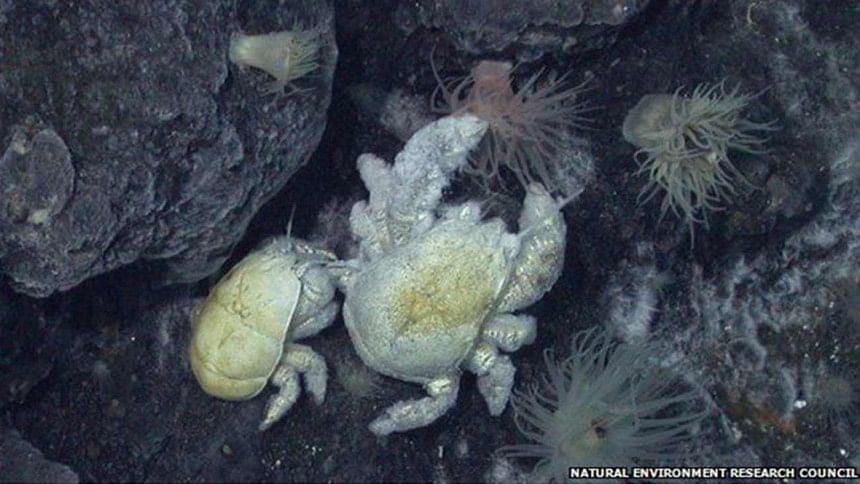'Hoff crab' gets formal scientific name

A hairy crab that was dubbed "The Hoff" when it was first found in Antarctic waters has now been given a formal scientific description and name.
The creature, which lives in vast communities around hot vents on the sea floor, will be known as Kiwa tyleri.
The name honours the renowned British polar and deep-ocean biologist Paul Tyler from Southampton University.
Its many hairs host bacteria that the animal harvests to sustain itself, a paper in PloS One journal reports.
"The entire belly of the crab is covered in setae that are designed to brush up and harbour bacteria on a large scale," Southampton's Dr Sven Thatje told BBC News.
The creature's humorous nickname, which references the oft bare-chested US actor David Hasselhoff, will no doubt stick in the public consciousness, but the scientific community's interest in this animal is altogether more serious because its existence raises really important questions about how life survives, evolves and spreads through deep-sea environments.
Kiwa tyleri's habitat is a sharply constrained comfort zone inside what are otherwise fiercely hostile surroundings.

The creature was found on East Scotia Ridge in the Southern Ocean, at a depth of 2,000m.
The waters down there are normally about zero Celsius, and to make a living the crab must crowd around so-called hydrothermal vents.
These are volcanic rock systems that draw water through cracks in the seafloor, super-heat it, load it with dissolved metals and other chemicals, and then eject it back into the ocean.
Specialized bacteria are able to exploit this hot fluid, and a whole ecosystem is then built on top of them.
The crab feeds by "farming" the bacteria on its setae, using comb-like mouthparts to scrape off the microbes so that it can eat them.
What is more, the crab has spines on its legs that allow it to climb the chimney-like structures that are common at these hot vent sites.
This means it can get into just the right position where the conditions for good food production can be maximized.
It is, however, a careful balancing act. Move too close to the vent openings and the crab can encounter temperatures near 400 degrees C; but clamber too far away and the animal will enter the surrounding frigidity of the Antarctic. And for this organism, that would not be survivable.
"Antarctic bottom-water is the coldest seawater you can have. Generally, there are very few crabs and lobsters in the Southern Ocean. And so Kiwa tyleri is essentially trapped in this very narrow envelope," said Dr Thatje. "That is the fascinating aspect of this species."
Pictures returned from East Scotia Ridge a few years ago by the British Isis deep-sea submersible showed hundreds of individuals crammed into every square metre of space inside its temperature sweetspot, which ranges between about 4 and 30-plus Celsius.

Kiwa tyleri is now the third such "yeti crab", as this type of animal is often called, to be described in the scientific literature. A couple of others are waiting to go through that process.
The two previous species - Kiwa puravida and Kiwa hirsute - both live in the Pacific basin, one near Antarctica and the other off Costa Rica.
The thinking is that the Pacific is where the yeti crabs originated before expanding eastwards, perhaps 10-20 million years ago, going into the Atlantic through the Drake Passage that separates South America and Antarctica.
It is presumed they spread along volcanic vent systems, which could have acted like stepping stones to assist their radiation around the globe.
But this is not as straightforward as it sounds. Active vents can be relatively short-lived and the distances between individual sites may be considerable.
Understanding how the yetis did it was a key issue that needed to be addressed by future studies, Dr Thatje said.

 For all latest news, follow The Daily Star's Google News channel.
For all latest news, follow The Daily Star's Google News channel. 



Comments